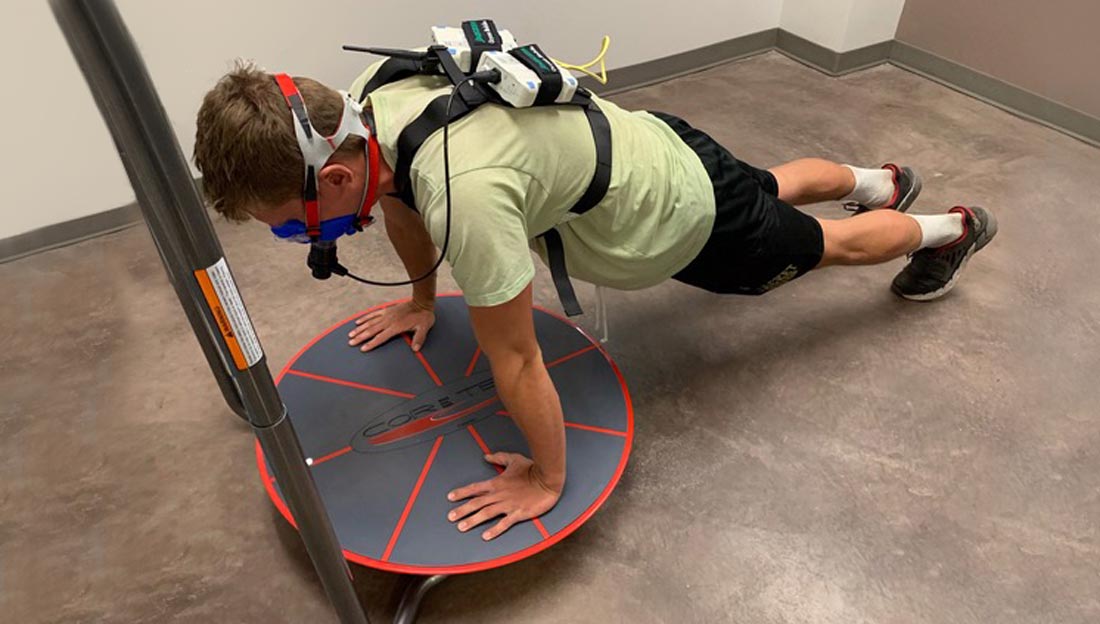
By Lance C. Dalleck, PhD, Bryant R. Byrd, MSc, Angela I. Carroll, Paige H. Forbes and Janinka B. Durchslag, with Daniel J. Green
Two of the biggest obstacles that health coaches and exercise professionals must overcome in supporting client adherence to exercise programs over the long term are a perceived lack of time and boredom with the program.
Enter the Core-Tex.
A relative newcomer to the fitness industry, the Core-Tex differs substantially in function from most fitness products in that it is based on the premise of reactive variability, meaning that it constantly provides variability to the muscles, nervous system and joints. The device is a padded platform cradled within a steel frame that contains three ball transfers to allow multidirectional and multiplanar movement. It’s a bit tough to envision how the Core-Tex works without seeing it in action, so be sure to check out the video links provided below.
Let’s take a quick look at the claims on the Core-Tex website:
“The Core-Tex is a reactive training device that combines dynamic strength, cardiovascular endurance, razor sharp reaction, flexibility and balance into ONE design, creating the optimal training environment.”

“The Core-Tex creates an environment that is proprioceptively rich, constantly providing variability to the muscles, nervous system and joints. Training on the Core-Tex causes reactive variability, meaning every exercise repetition is different, thereby reducing stress on the joints, continually requiring the nervous system to coordinate new movements and increasing muscle activation. The results? Your body achieves more in a shorter amount of time, gets smarter with less stress and stays fully engaged.”
It is important to note that a well-balanced exercise program features cardiorespiratory, resistance, flexibility and neuromotor (i.e., agility and balance) training, and the Core-Tex is designed to address all of those elements of fitness during each workout. If true, this would help solve the “perceived lack of time” issue, while the exercise variability may address client boredom.
To put this product to the test, ACE enlisted the help of Lance Dalleck, PhD, and his team of researchers in the High Altitude Exercise Physiology Program at Western Colorado University. The purpose of this study was twofold: (1) to quantify the acute physiological responses to exercise with the Core-Tex and (2) to determine the effectiveness of a six-week chronic exercise training program using the Core-Tex for improving cardiorespiratory, muscular, flexibility and neuromotor fitness.
The Study
The research team recruited 15 healthy men and women to participate in the study [Age = 26.1 ± 6.8 years; Height = 5’7” ± 3.6” (171.6 ± 9.3 cm); Weight = 141.9 ± 27.9 lb (64.5 ± 12.7 kg); all values given as mean ± standard deviation). Participants were eligible for inclusion in the study if they were physically inactive as defined by the American College of Sports Medicine (ACSM, 2018). None of the participants had any evidence of cardiovascular, pulmonary and/or metabolic disease.
Acute Responses to Exercise with the Core-Tex
To quantify acute cardiovascular and metabolic responses to Core-Tex exercise, the researchers had each participant wear a portable calorimeter and heart-rate monitor throughout two 30-minute sessions: one upper-body/core day and one lower-body/core day. The responses across these two sessions were averaged.
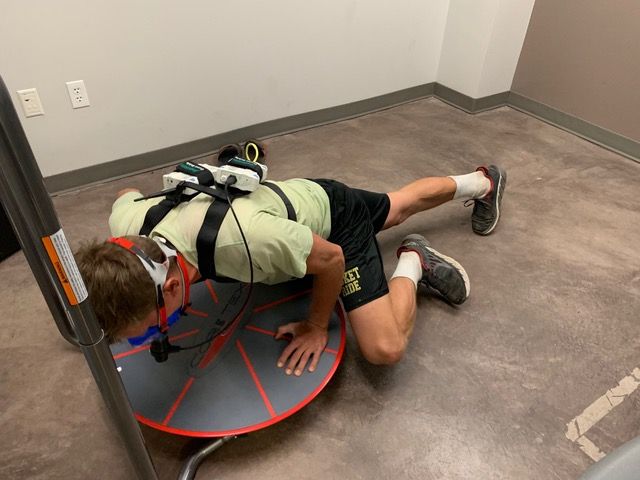
Chronic Responses to Exercise with the Core-Tex
At baseline and post-program, the participants performed a graded exercise test on a treadmill to determine cardiorespiratory fitness via maximal oxygen uptake (VO2max). In addition, muscular fitness, flexibility and neuromotor fitness were assessed at baseline and post-program. Specifically, the following assessments were conducted to determine the effectiveness of a six-week Core-Tex program:
- Maximal exercise test to determine cardiorespiratory fitness (i.e., VO2max)
- Sit-and-reach test to assess flexibility
- Five-repetition maximum (5-RM) assessment for bench press and leg press to quantify muscular fitness
- Plank test to assess core muscular fitness
- Pro Agility shuttle run to assess agility
- Y balance test to assess the impact of reactive variability training on balance
The Training Program
All participants completed a standard six-week Core-Tex training program (Table 1). The program consisted of four 30-minute sessions each week. While they could complete the sessions whenever they chose, participants were encouraged to train no more than three consecutive days. All sessions were performed within group classes of three to four participants supervised by a member of the research team.
Be sure to view the following videos to see the Core-Tex in action. These videos contain all of the exercises listed in Table 1.
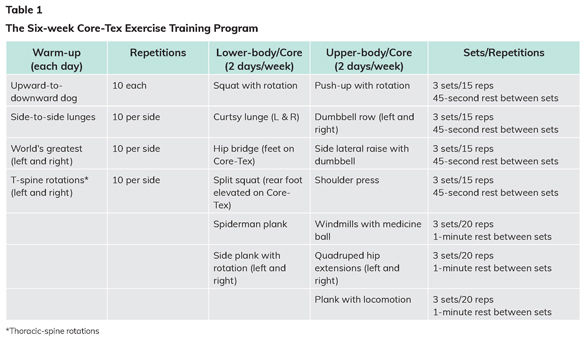
The Results
Acute Responses to Exercise with the Core-Tex
The acute cardiovascular and metabolic responses to a Core-Tex exercise session are presented in Table 2, while Figure 1 illustrates the exercise intensity in terms of heart-rate reserve (the difference between resting and maximal heart rate) for a representative participant throughout the duration of a training session.

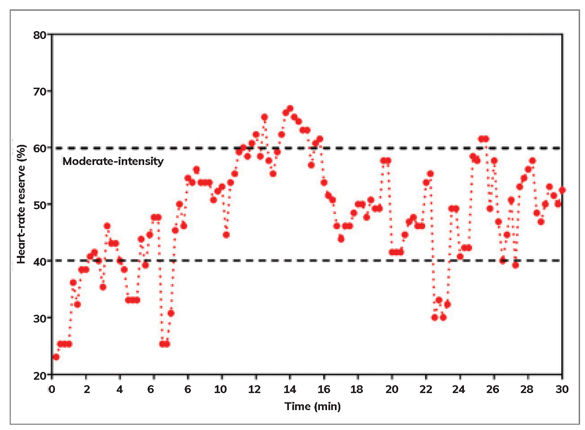
Figure 1
Exercise intensity in terms of heart-rate reserve (HRR) for a representative participant throughout the duration of a Core-Tex exercise-training session. The space between the dashed lines (---------) represents moderate-intensity exercise classification.
Chronic Responses to Exercise with the Core-Tex
The fitness-related responses to exercise training with the Core-Tex are presented in Table 3. At six weeks, statistically significant favorable changes were seen in all fitness domains (i.e., cardiorespiratory, muscular, flexibility and neuromotor).
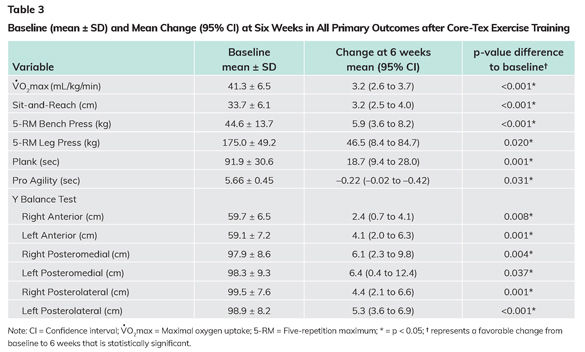
The Bottom Line
The results of this study provide two preliminary lines of evidence supporting the Core-Tex as an exercise modality that may be effective in overcoming the common obstacles highlighted earlier in this article—perceived lack of time and boredom:
- The typical Core-Tex exercise session elicited cardiovascular and metabolic responses that fulfill exercise intensity guidelines for improving and maintaining cardiorespiratory fitness (ACSM, 2018; ACE, 2010). Mean exercise intensity was 48.1% of heart-rate reserve (%HRR) and 4.8 metabolic equivalents (METs). The %HRR value and the MET level both fall within ranges identified as moderate-intensity exercise (ACSM, 2018; U.S. Department of Health and Human Services, 2018). Overall energy expenditure for a 30-minute Core-Tex exercise session was 162 kcal.
- Participation in a six-week exercise-training program with the Core-Tex positively modified various fitness domains. In fact, the findings demonstrated that the Core-Tex may simultaneously satisfy training guidelines for cardiorespiratory, flexibility, neuromotor and muscular fitness. This level of training may contribute to a decrease in cardiovascular disease risk and all-cause mortality risk.
The Core-Tex website says that using the device touches on all domains of fitness simultaneously. According to Dr. Dalleck, “The data from this study clearly supports that statement.”
Considering that established guidelines recommend the performance of multiple sessions of each of the four components of fitness (i.e., cardiorespiratory, muscular, flexibility and neuromotor training), having a device that can simultaneously address multiple (or even all) components would go a long way to overcoming the “perceived lack of time” barrier.
But what about boredom? According to Dr. Dalleck, “There are literally dozens and dozens of combinations of exercises and the continued novelty of each repetition being performed a bit differently should be enough to stimulate clients both physiologically and mentally.”
References
American College of Sports Medicine (2018). ACSM's Guidelines for Exercise Testing and Prescription (10th ed.). Philadelphia: Wolters Kluwer.
American Council on Exercise (2014). ACE Personal Trainer Manual (5th ed.). San Diego: American Council on Exercise.
U.S. Department of Health and Human Services (2018). Physical Activity Guidelines for Americans (2nd ed.).
This research study was first published in the peer-reviewed
International Journal of Research in Exercise Physiology.





 by
by 









